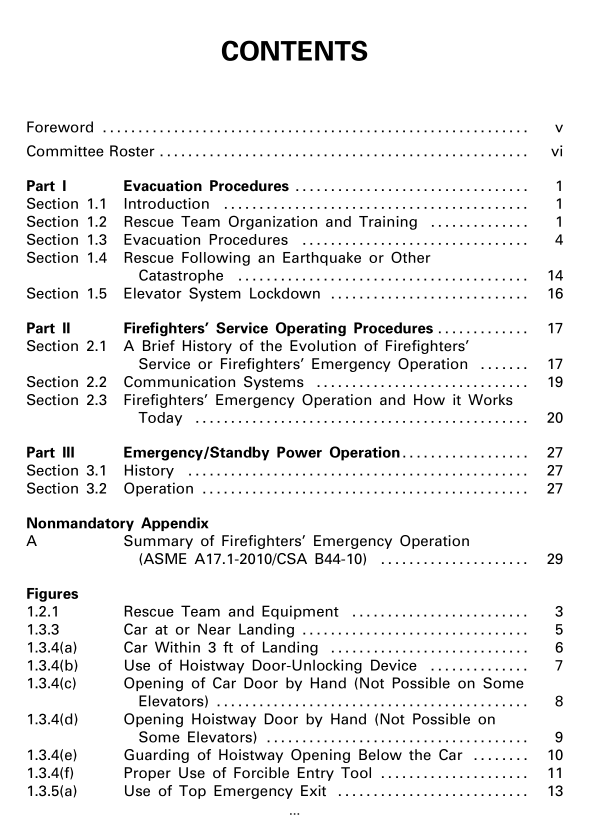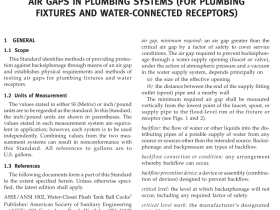ASME A17.4 pdf download

ASME A17.4 pdf download Guide for Emergency Personnel (Includes Evacuation Procedures and Firefighters’ Service Operating Procedures)
(4) A member of the rescue team should enter the elevator car and set the emergency stop switch, if the car is so equipped, in the “STOP” or “OFF” position. If the car is equipped with a key-operated, in-car stop switch, use the key, if available, to turn the switch to the “OFF” position. Where the in-car stop switch is located behind a locked panel, unlock the panel and activate the stop switch.
(5) The passengers should then be assisted from the stalled elevator car, one at a time, by rescue personnel located both in the car and on the landing. A sturdy stepladder or footstool should be used for safe removal. Precautions should be taken to guard any hoistway opening below the car floor (platform) when the elevator car is above the landing [see Fig. 1.3.4(e)]. Again, a ladder, backboard, basket stretcher, or solid piece of furniture can be used for this purpose.
1.3.5 Procedure With Car More Than 3 ft (914 mm) From Landing When an elevator car is stalled so that the car floor (platform) is more than 3 ft (914 mm) above a landing level, it is inadvisable to remove the passengers through the elevator door opening, as the excessive distance between the car floor (platform) and landing level creates a danger due to the possibility that a passenger may fall into the hoistway. In addition, it is inadvisable to remove passengers through the elevator door opening when the car floor (platform) is more than about 3 ft (914 mm) below the landing level, since the reduced opening clearance makes exiting too difficult. The recommended methods for removing the passengers under these conditions are as follows:
(a) Removal Through Top Emergency Exit
CAUTION: Do not use the car top emergency exit on an elevator in an unenclosed hoistway. New elevators in unenclosed hoistways will not have top emergency exits. Ifexiting through the elevator entrance is not possible, have experienced elevator personnel move the elevator car to a landing level. The tops of elevator cars may have a lot of equipment, and secure footing may not be obvious. Additionally, debris can collect, along with dirt, oil, etc.
1) The mainline disconnect switches in the machine room for the stalled elevator and the adjacent elevators (if the stalled elevator car is located in a multiple hoistway) should be set in the “OFF” position. Lockout/tagout the mainline disconnect switch.
(2) The rescue team should open the hoistway door at the nearest landing or an emergency access door, where provided, above the stalled elevator car top. This entry can be made by the use of the hoistway door-unlocking device or the emergency door key, or by forcing open the hoistway doors.
(3) A ladder with nonskid feet should be lowered to the elevator car top and securely positioned on the elevator car top. This ladder should be of sufficient length to extend at least 3 ft (914 mm) above the landing floor [see Fig. 1.3.5(a)].
(4) One member of the rescue team, equipped with a personal fall arrest system and properly tied off to a secured lifeline, should descend to the top of the stalled elevator car. The top of car stop switch should be placed in the “STOP” position to ensure that the elevator will not move. A second ladder should be lowered through the top emergency exit and positioned between the elevator car floor and car top in order to safely transport the passengers to the car top.
(5) A second rescue team member, also equipped with a personal fall arrest system and properly tied off to a secured lifeline, should then descend to the car top. The team member should carry an additional personal fall arrest system for use in rescuing the passengers.
(6) One team member should then enter the stalled elevator car through the top emergency exit. The other rescue team member should remain on the top of the stalled elevator car. A third member should be at the landing used to gain access to the hoistway.
(7) The emergency stop switch in the stalled elevator car, if the car is so equipped, should be set in the “STOP” or “OFF” position. If the car is equipped with a key-operated, in-car stop switch, use the key, if available, to turn the switch to the “OFF” position. Where the in-car stop switch is located behind a locked panel, unlock the panel and place the stop switch in the “OFF” position.
(8) The passengers should then be assisted, one at a time, from within the elevator car to the car top, then to the landing above with the use of personal fall arrest systems and secured lifelines.
(b) Removal Using Side Emergency Exit, When an Adjacent Elevator With a Matching Side Emergency Exit Is Available.









